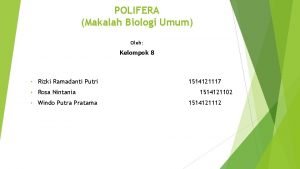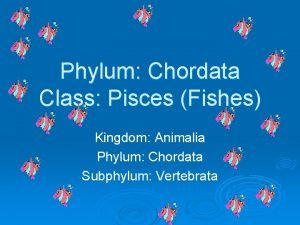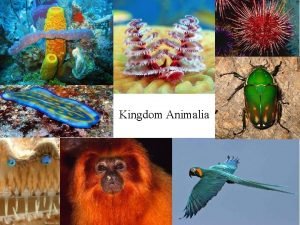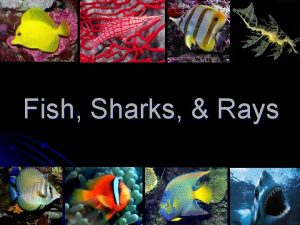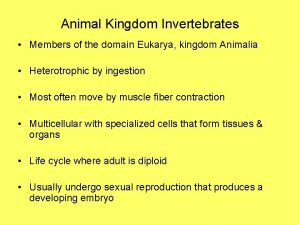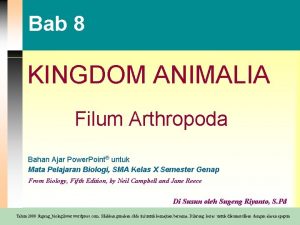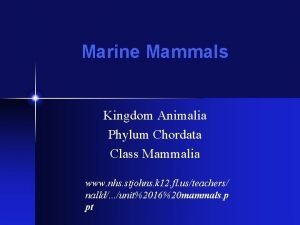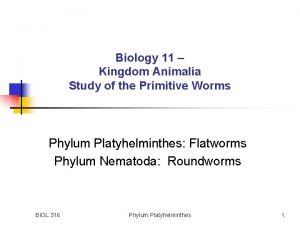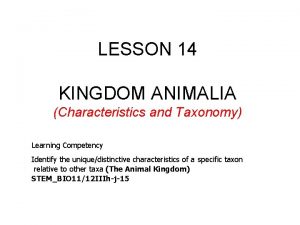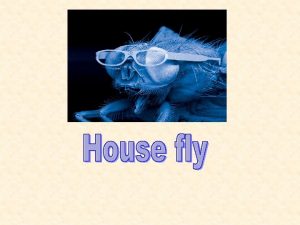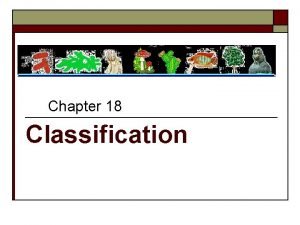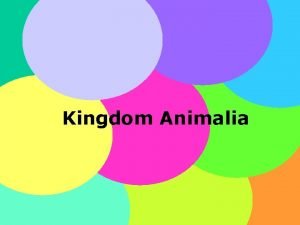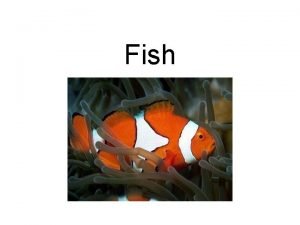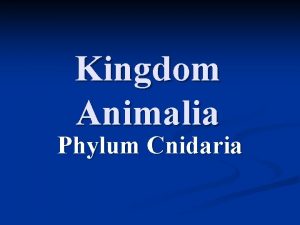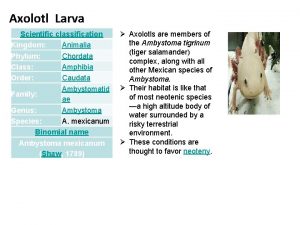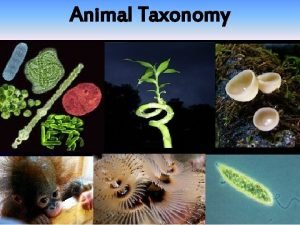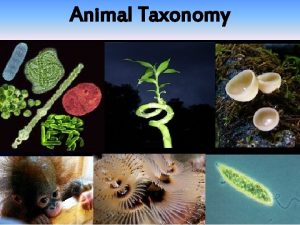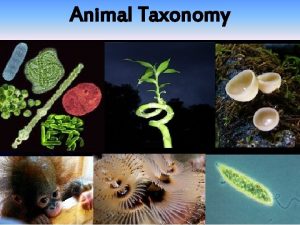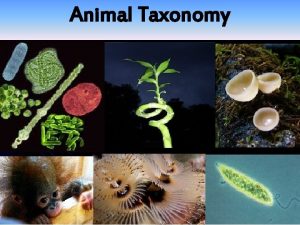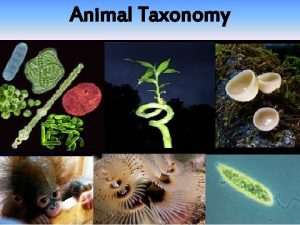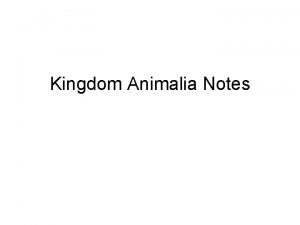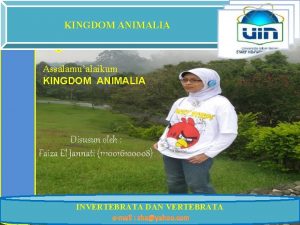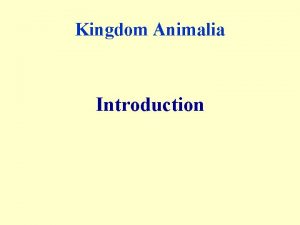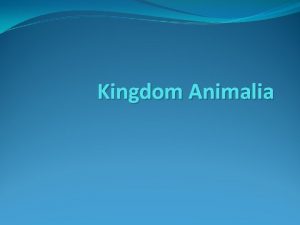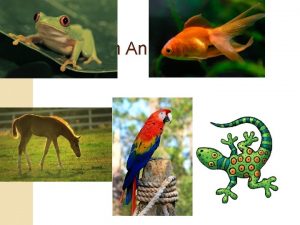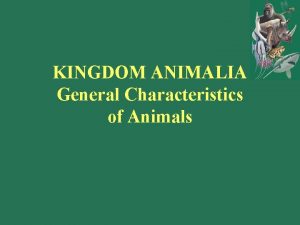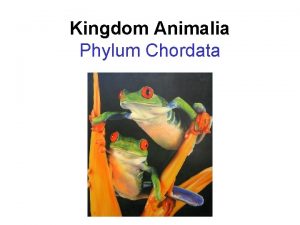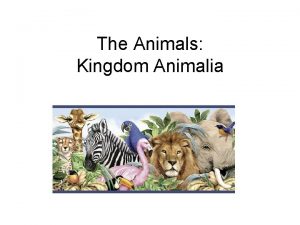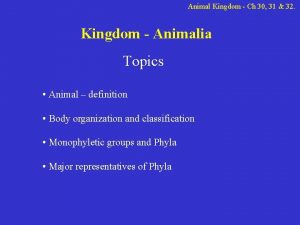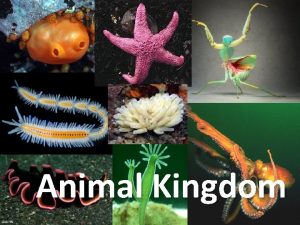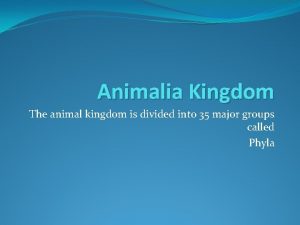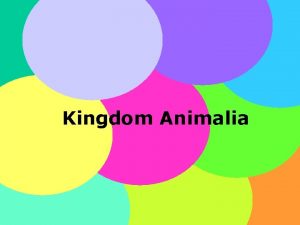Animal Kingdom Ch 30 31 32 Kingdom Animalia
























- Slides: 24

Animal Kingdom - Ch 30, 31 & 32. Kingdom - Animalia Topics • Animal – definition • Body organization and classification • Monophyletic groups and Phyla • Major representatives of Phyla • Ecology and economy

Animal Kingdom - Ch 30, 31 & 32. pp. 622 -626. What is an Animal? • Very diverse with some common characteristics – – – Multicellular eukaryotes Heterotrophs Cells are specialized - for various functions Most - capable of locomotion Most - nervous systems and muscles Most - diploid and reproduce sexually • Zygote cleaves starting embryogenesis • Morula, blastula, gastrula, larva, metamorhosis • Evo-devo and Hox genes

Animal Kingdom - Ch 30, 31 & 32. pp. 624 -626. Classification - criteria • Earliest fossils ~600 mya; land ~440 mya • <5% of all animals are vertebrates – Includes fish, amphibians, reptiles, birds, mammals • Invertebrates lack backbone – Includes sponges, jellyfish, worms, mollusks, insects, crustaceans

Animals - Ch 30, 31 & 32 pp. 626 -632. Classification - criteria • Parazoa (sponges) and Eumetazoa • Eumetazoa - radial or bilateral symmetry – Radial: body arranged as spokes in a wheel – Bilateral: body arranged as mirror-image along a central axis • Most eumetazoans - bilaterally symmetric – Each half identical, or very similar at least – Tendency toward cephalization - head with sensory structures, neural integrating systems located – Diploblastic or triploblastic – Triploblastic – acoelomates, pseudocoelomates, coelomates

Animals - Ch 30, 31 & 32 p. 626 -633. Classification - criteria • Ectoderm: outer layer - makes outer covering, nervous system • Endoderm: lining of the digestive tube and digestive organs – Cnidarians and ctenophores are diploblastic • Mesoderm: muscles, skeleton, and circulatory system – All animals besides the Cnidara and Ctenophora are triploblastic

Triploblastic Body Plans • Acoelomates • Pseudocoelomates (probably evolved by simplification of coelomates – not monophyletic) • Coelomates Animals - Ch 30, 31 & 32 pp. 626 -633.

Animals - Ch 30, 31 & 32 pp. 628 -633. Protostomes and Deuterostomes • During gastrulation - cells move, blastopore forms • Protostomes – Blastopore becomes mouth – Spiral cleavage in embryo – Determinate cleavage - Embryonic cells develop into fixed body parts • Deuterostomes – Blastopore becomes anus, second pore - mouth – Radial cleavage – Indeterminate cleavage - Each cell can make an adult

Animals - Ch 30, 31 & 32 p. 629.

Animals - Ch 30, 31 & 32 p. 632. 6 main animal clades based on molecular data Parazoa, Radiata, Biradiata, Lophotrochozoa, Ecdysozoa, Deuterostomia

Phylum – Porifera (Parazoans) • Choanocytes (collar cells) - help move water through - trap suspended food items • Amoeboid cells move about mesohyl - important in nutrition • Mesohyl - important in sexual reproduction; holds egg and embryo (most are hermaphroditic) • Division of labor without tissues Animals - Ch 30, 31 & 32 pp. 635 -638.

Phylum – Cnidaria (Radiata) • Cnidocytes stinging cells • Two body forms/stages – Medusa and Polyps – many spp. have both • Two definite tissue layers – Epidermis, Gastrodermis - Separated by the gelatin-like mesoglea • Nerve net - no head Both stages common, but not in hydra Animals - Ch 30, 31 & 32 pp. 638 -642.

Protostome Lophotrochozans Phylum - Platyhelminthes Animals - Ch 30, 31 & 32 pp. 643 -647. Classes: Tubelaria - free living; Trematoda and Monogenea - parasitic flukes; Cestoda - tapeworms (vertebral intestinal parasites)

Phylum - Mollusca • Clams, oysters, snails, slugs, octopi, squids Trochophore larva - fresh water and marine • Common features: Soft body, dorsal calcium carbonate shell in some, muscular foot – locomotion, organs form viscera, mantle secretes shell, open circulatory system - hemolymph bathes tissues Animals - Ch 30, 31 & 32 pp. 647 -650.

Phylum - Annilida • • Animals - Ch 30, 31 & 32 pp. 651 -653. Segmented worms – Trochophore larva Class - Polychaeta - sandworms - mainly marine Class - Oligochaeta - earthworms - land fresh water Class - Hirudinea - leeches - mainly fresh water • Body - ringed segments • Some structures - repeated in each segment - e. g. excretory organs metanephridia • Some organ systems occur in full length - e. g. nervous, digest. Segmentation aids movement - each segment can move • Nervous system – ventral • Respiration – cutaneous • Earthworm – make soils more fertile

Animals - Ch 30, 31 & 32 p. 651 -653. Mostly marine Terrestrial/freshwater Mostly freshwater

Animals - Ch 30, 31 & 32 pp. 656 -658. Protostome Ecdysozoans Phylum – Nematoda - Roundworms • Decomposers and predators – most are free living • Pseudocoelomates • 50< spp. – human parasites – e. g. Ascaris worm, hookworms, pinworms, trichina worm

Animals - Ch 30, 31 & 32 pp. 656 -666 Phylum – Arthropoda – Jointed appendages & chitin exoskeleton • > 1 million species; probably millions to be known • Most successful and diverse - >80% of all animal spp. • Distinct anatomical features/adaptations: • • • Segmented body Tough exoskeleton – discuss advantages and disadvantages Paired, jointed appendages Antennae - taste and touch Most insects and crustaceans - compound eyes Open circulatory system 1. Dorsal heart pumps hemolymph to a dorsal artery 2. Flows through smaller arteries to hemocoel, where it baths tissues

Animals - Ch 30, 31 & 32 p. 658. Subphyla Selected classes Characteristics Myriapoda Chilopoda - Centipedes Diplopoda - Millipedes Head + seg. Body, uniramous, 1 pair antennae, mandibles and maxillae Chelicerata Mirostoma - Hor. shoe crabs Arachnida - Spiders, scorpions, ticks, mites Cephalothorax + abdomen, uniramous, no antennae, chelicerae and pedipalps Crustacea Malacostraca - Lobsters, crabs, shrimps, isopods Cirripedia - Barnacles Cephalothorax + abdomen, biramous, 2 antennae pairs, mandibles and maxillae Hexapoda Insecta - Bees, ants, beetles roaches, flies, mosquitoes, grasshoppers Head + thorax + abdomen, uniramous, 1 pair antennae, mandibles and maxillae

Deuterostomes Animals - Ch 30, 31 & 32 p. 670 -675.

Deuterostomes – Phylum - Echininodermata Animals - Ch 30, 31 & 32 p. 674. Echinoderms – Hydraulic/water vascular system – locomotion, feeding and gas exchange

Animals - Ch 30, 31 & 32 p. 671 -673.

Animals - Ch 30, 31 & 32 pp. 675 -678. Deuterostomes – Phylum – Chordata Model – Lancelet – Amphioxus sp. Endostyle – Mucus secreting pharyngeal groove (thyroid is a derivative) – fourth chordate character

Animals - Ch 30, 31 & 32 p. 678 -681. Study Table 32 -2

Animals - Ch 30, 31 & 32 p. 696 -699. Class - Mammalia – – – – Hair Mammary glands Differentiated teeth Three middle-ear bones Constant body temperature Highly-developed nervous system - neocortex Muscular diaphragm Two clades – Protheria and Theria
 Animal classification domain
Animal classification domain Youtube egypt
Youtube egypt Mentohotep
Mentohotep Old kingdom middle kingdom new kingdom
Old kingdom middle kingdom new kingdom Nnn ruled
Nnn ruled Manfaat calcarea
Manfaat calcarea Kingdom pisces
Kingdom pisces Monogenea class
Monogenea class Shark class
Shark class Domain eukarya kingdom animalia
Domain eukarya kingdom animalia Kingdom animalia arthropoda
Kingdom animalia arthropoda Kingdom animalia phylum chordata
Kingdom animalia phylum chordata Biology kingdom animalia
Biology kingdom animalia Mammals characteristics
Mammals characteristics Diptera phylum
Diptera phylum What are the rules for writing scientific names
What are the rules for writing scientific names Monera protista fungi plantae animalia
Monera protista fungi plantae animalia Kubung merupakan hewan bersayap kulit termasuk ordo
Kubung merupakan hewan bersayap kulit termasuk ordo Single loop blood circulation
Single loop blood circulation Kingdom protista prokaryotic or eukaryotic
Kingdom protista prokaryotic or eukaryotic Kingdom animalia phylum cnidaria
Kingdom animalia phylum cnidaria Kingdom plantae cladogram
Kingdom plantae cladogram Characteristics of cnidaria
Characteristics of cnidaria Axolotl scientific classification
Axolotl scientific classification Insecta class
Insecta class





